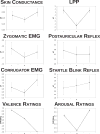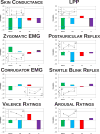Reduced positive emotion and underarousal are uniquely associated with subclinical depression symptoms: Evidence from psychophysiology, self-report, and symptom clusters
- PMID: 28322458
- PMCID: PMC5493475
- DOI: 10.1111/psyp.12853
Reduced positive emotion and underarousal are uniquely associated with subclinical depression symptoms: Evidence from psychophysiology, self-report, and symptom clusters
Abstract
Multiple models of aberrant emotional processing in depression have been advanced. However, it is unclear which of these models best applies to emotional disturbances in subclinical depressive symptoms. The current study employed a battery of psychophysiological measures and emotional ratings in a picture-viewing paradigm to examine whether the underarousal, low positive emotion, heightened negative emotion, or emotion context insensitivity model of emotional dysfunction in subclinical depressive symptoms received greatest support. Postauricular reflex and skin conductance response potentiation for pleasant minus neutral pictures (measuring low positive emotion), overall skin conductance magnitude and late positive potential (LPP) amplitude (measuring underarousal), and pleasant minus aversive valence ratings (measuring emotion context insensitivity) and aversive minus neutral arousal ratings (measuring heightened negative emotionality) were all negatively related to depressive symptomatology. Of these, postauricular reflex potentiation and overall LPP amplitude were incrementally associated with depressive symptoms over the other measures. Postauricular reflex potentiation, overall skin conductance magnitude, and aversive minus neutral arousal ratings were incrementally associated with depressive symptomatology after controlling for other symptoms of internalizing disorders. Though no model was unequivocally superior, the low positive emotion and underarousal models received the most support from physiological measures and symptom reports, with self-report data matching patterns consistent with the emotion context insensitivity model.
Keywords: depression; emotion context insensitivity; low positive emotion; postauricular reflex; skin conductance; underarousal.
© 2017 Society for Psychophysiological Research.
Figures



Similar articles
-
Postauricular reflexes elicited by soft acoustic clicks and loud noise probes: Reliability, prepulse facilitation, and sensitivity to picture contents.Psychophysiology. 2016 Dec;53(12):1900-1908. doi: 10.1111/psyp.12757. Epub 2016 Sep 6. Psychophysiology. 2016. PMID: 27596354 Free PMC article.
-
Depressed mood and emotional responding.Biol Psychol. 2010 May;84(2):368-74. doi: 10.1016/j.biopsycho.2010.04.004. Epub 2010 Apr 21. Biol Psychol. 2010. PMID: 20416354
-
Associations between self-report and physiological measures of emotional reactions to food among women with disordered eating.Int J Psychophysiol. 2019 Oct;144:40-46. doi: 10.1016/j.ijpsycho.2019.08.004. Epub 2019 Aug 12. Int J Psychophysiol. 2019. PMID: 31415796
-
Emotion, attention, and the startle reflex.Psychol Rev. 1990 Jul;97(3):377-95. Psychol Rev. 1990. PMID: 2200076 Review.
-
Emotion, motivation, and anxiety: brain mechanisms and psychophysiology.Biol Psychiatry. 1998 Dec 15;44(12):1248-63. doi: 10.1016/s0006-3223(98)00275-3. Biol Psychiatry. 1998. PMID: 9861468 Review.
Cited by
-
Depressive symptoms are associated with reduced positivity preferences in episodic memory in aging.Neurobiol Aging. 2023 Jan;121:38-51. doi: 10.1016/j.neurobiolaging.2022.10.006. Epub 2022 Oct 20. Neurobiol Aging. 2023. PMID: 36371815 Free PMC article.
-
Can peripheral psychophysiological markers predict response to exposure-based cognitive behavioral therapy in youth with severely impairing irritability? A study protocol.BMC Psychiatry. 2023 Dec 11;23(1):926. doi: 10.1186/s12888-023-05421-4. BMC Psychiatry. 2023. PMID: 38082431 Free PMC article.
-
Divergences among Three Higher-Order Self-Report Psychopathology Factors in Normal-Range Personality and Emotional Late Positive Potential Reactivity.J Res Pers. 2019 Oct;82:103861. doi: 10.1016/j.jrp.2019.103861. Epub 2019 Aug 17. J Res Pers. 2019. PMID: 32863467 Free PMC article.
-
Postauricular reflexes elicited by soft acoustic clicks and loud noise probes: Reliability, prepulse facilitation, and sensitivity to picture contents.Psychophysiology. 2016 Dec;53(12):1900-1908. doi: 10.1111/psyp.12757. Epub 2016 Sep 6. Psychophysiology. 2016. PMID: 27596354 Free PMC article.
-
Safety learning during development: Implications for development of psychopathology.Behav Brain Res. 2021 Jun 25;408:113297. doi: 10.1016/j.bbr.2021.113297. Epub 2021 Apr 18. Behav Brain Res. 2021. PMID: 33862062 Free PMC article. Review.
References
-
- American Psychiatric Association. Diagnostic and statistical manual of mental disorders. 5th. Arlington, VA: American Psychiatric Publishing; 2013.
MeSH terms
Grants and funding
LinkOut - more resources
Full Text Sources
Other Literature Sources
Medical

